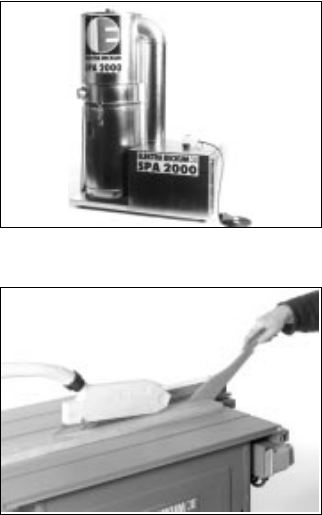
22
General Safety Precautions
- FOR YOUR OWN SAFETY; READ AND UNDERSTAND INSTRUCTION MANUAL BEFORE OPERATING
- THE SAW: Learn the saw’s applications as well as the specific hazards peculiar to it.
- KEEP GUARDS IN PLACE and in working order.
- REMOVE ALL ADJUSTING KEYS AND WRENCHES: Form habit of checking to see that all keys and adjusting wrenches
are removed from tool before switching it “ON”.
- ALWAYS USE SAW BLADE GUARD AND RIVING KNIFE for every operation for which they can be used, including through
sawing. Through sawing operations are those when the blade cuts completely through the work piece as in ripping or cross
cutting.
- ALWAYS HOLD WORK FIRMLY AGAINST RIP FENCE OR MITRE FENCE.
- USE PUSH-STICK if distance between blade and rip fence is less than 120 mm / 5 in.
- NEVER PERFORM ANY OPERATION “FREE-HAND”.
- NEVER REACH BEHIND, OVER OR UNDER THE CUTTING TOOL WITH EITHER HAND FOR ANY
- REASON. Keep hands away from saw blade; do not reach into area 120 mm / 5 in. left and right of saw blade.
- DIRECTION OF FEED: Feed work into saw blade against direction of rotation only.
- AVOID KICKBACKS (work thrown back at you) by keeping the rip fence parallel to the blade, keeping riving knife and guards
in place and operating, by not releasing work before it is pushed all the way past the saw blade, and by not ripping stock
that is twisted or warped or does not have a straight edge to guide along the fence.
If not in place install riving knife and saw blade guard, set as per paragraph 5.6
of this manual. Set depth of cut to approx. 10 -15 mm more than the workpiece
thickness and rip fence to desired width of cut. Start saw only after all setting
have been made. Place workpiece against the fence and feed into the blade
in a steady motion. Do not force work, as this may overload the motor.
- When ripping strips less then 120 mm wide always use pushstick supplied with
machine for feeding the work to prevent personal injury.
Safety Precautions particularly for this Saw Model PK 300 K
- Before operating the saw check if saw blade is mounted correctly and arbor bolt tightened. Check if blade turns freely.
- Large or long stock, which may tilt the saw by its weight, must be supported at both infeed and outfeed side of the table
by suitable means, e.g. the Roller Table Extensions available as optional accessory, saw horses or other supports of
suitable height.
- Never cut round stock without using suitable jigs.
- Do not use High Speed Steel (HSS) saw blade on this saw.
- Perform crosscuts only with the crosscut/mitre fence, or with a Sliding Carriage (optional accessory).
- Replace dull or cracked saw blades at once.
- Replace kerf plate if worn.
- Set guards as required for the job on hand.
- If operated indoors use a dust collector with a minimum air flow rate of 20 mtr/sec at the suction port.
9.1 Problems
- If the saw blade is stalled by waste, switch machine off and let blade come to a complete standstill before removing
obstruction.
- Switch motor off at once if blade is stalled. A dull blade is likely to be the cause, which may cause motor overloads.
- A dull blade may be the reason for what appears to be a loss of power.
- An extremely dull blade leaves burn marks in the kerf. The heat generated by friction may temper the blade body. Replace
at once to prevent overloading the motor.
- After a power failure the motor has to be restarted by switching ON again.
- Resin residue on the blade affects performance. Clean regularly.
- If the saw blade needs more than 10 sec. to come to a complete standstill the motor brake is worn. Have repaired by a
qualified electrician.
10 Dust Collection
The Precision Circulars Saws models PK 300 K must be connected to a dust
collector (e.g. Elektra Beckum model SPA 2000). The standard dust collection
port has a nominal diameter of 100 mm.
Adhere to all local codes and directives regarding dust collection on woodwor-
king machines.
11 Operation
11.1 Through Sawing


















